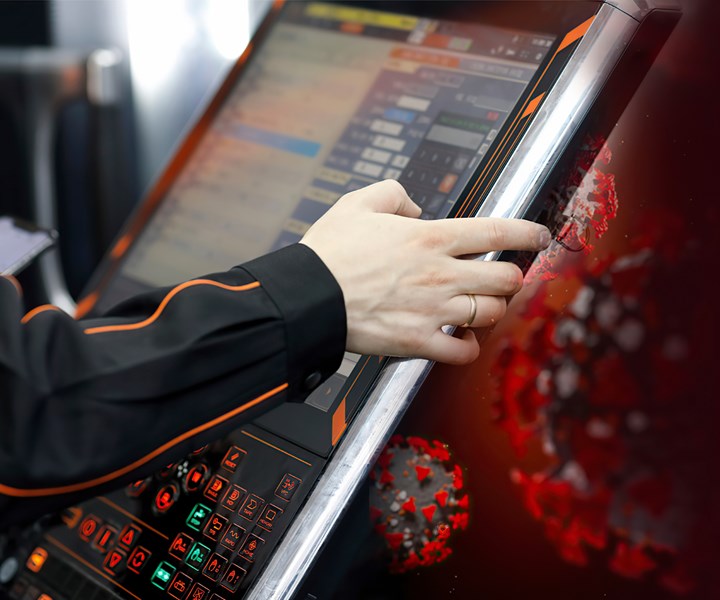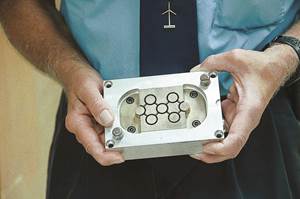Follow These Tips to Sanitize Machine Controller Screens & Buttons
Keeping your workers safe from the coronavirus makes it extremely important to institute a sanitizing procedure on all touch surfaces of the controller, screen and operating panel. I did some research and here’s what I found.
We as processors tend to take the machine’s controller and operating panel for granted. We like some and despise others, but rarely do we give them the attention they deserve. Daily production pressures such as process interruptions, part defects, resin issues, etc., keep you so busy that the controller screen and buttons don’t really register as components that need attention. We just expect the controller to function properly … and most of the time it does.

Many shops may not clean their control panels regularly, but now is the time to develop new habits.
But now, with the COVID-19 pandemic, it’s time to recognize the controller as another touchscreen that can have the live virus on it. This means it must be sanitized, not just cleaned. It needs appropriate attention, as it’s a critical component of every machine. We all love to push the buttons and turn the knobs. Think about it, most controller screens are at eye level. Usually we work fairly close to the screen so we can see their inputs and process parameters or values. If anyone coughs or sneezes, tiny droplets can fly “up to about 26 ft and on average roughly 20 ft,” according to the U.S. Centers for Disease Control. Essentially, that contaminates everything on the screen and control panel. Plus the viruses are hardy little buggers that can persist for hours up to a few days on some surfaces.
It’s time to recognize the controller as another touchscreen that can have the live virus on it.
How often do you touch the screen and push the buttons? Can you remember the last time the screen and buttons were even cleaned, let alone sanitized? Now, for your own health and others, it is imperative that you take time to sanitize your machine screens and buttons. Maybe you thought nothing could live with all the grime and oil buildup there, but times they are a changing. We need to work at preventing the spread of the virus to ourselves and others. So, what is the best way to sanitize the controller screen?
Stop—do not pick up the nearest wipe or hand sanitizer. That controller is expensive, and costs thousands of dollars to replace. So you don’t want to scratch, chemically etch, smear, remove labels, fog up, or ruin the touch sensitivity of the screen. It would be nice if they were made of glass—that would make things easy—but most are similar to your computer, tablet or cellphone screens. They are likely to be covered with a touch-sensitive plastic film, which may be harmed by some cleaners. The goal is to sanitize, not damage or fog up the screen. The National Institutes of Heath (NIH) states, “The virus that causes coronavirus disease 2019 (COVID-19) is stable for several hours to days in aerosols and on surfaces, according to a new study from National Institutes of Health, CDC, UCLA and Princeton University scientists in The New England Journal of Medicine.”
For your own health and others, it is imperative that you take time to sanitize your machine screens and buttons.
So the virus can live a few hours to a few days on some of these surfaces. Hence, we now go from rarely (never) cleaning the controller screen and panel to keeping the screens and buttons free of these dirty devils. How much sanitizing can these screens take?
No easy answer to this, and you will need to monitor how your controllers are holding up to whatever procedure you implement. How often do you need to do it? My guess is a minimum of once a shift, but since there are few test kits at this time, we don’t know who has the virus; so perhaps several times a shift. Frequency probably depends on how many people use the controller.
Next question: What sanitizer is best for your controllers? First step is to contact the machine manufacturer and see what it recommends. My initial queries got next-day responses, with the recommendations of soapy water and 70% isopropanol (rubbing alcohol). Both are known to kill the virus, but is there something better? An internet search turns up a list of about 300 disinfectants that kill the SARS-CoV-2 coronavirus, which is responsible for the disease labeled COVID-19.
This list also provides the necessary contact time to kill the virus. It takes 30 sec to 5 min to kill the SARS-CoV-2 coronavirus, depending the active ingredient(s) of the sanitizing agents. Now 30 sec is not a single swipe. For isopropanol the listed time was 5 min. For hydrogen peroxide it takes 0.5 to 2 min. For some reason soapy water is not on the list. I urge you not to use bleach on your controller.
There is also the choice of wearing latex or vinyl gloves, but is that practical for an entire shift? And if the bugs are there now, the gloves are then contaminated and we have the same issue with spreading the virus on anything we touch. And how well do these gloves work on touch-sensitive screens?
Suggested Sanitizer Solutions (use at your own risk.)
1. Solution of nine parts (90%) of either 70% isopropyl alcohol or 60% ethanol and one part (10%) hydrogen peroxide, and add two drops of Dawn dish soap per 500 ml (1 pint).
2. Solution of 3% hydrogen peroxide
3. UV light will also work and work fast, but the apparatus is expensive.
Note: I suggest adding two drops of Dawn dish soap per 500 ml (1 pint) of the above solutions to help wet the screen/panel surface, but this may slightly deplete the oleophobic coating on some touchscreens. Since this coating wears away under normal use and can be reapplied, I do add the soap.
Recommended Procedure
It is best if you can power down the machine. Yes, I know this is time- consuming and problematic for barrel heats and machine restart time. But accidently changing a processing parameter or pushing the wrong button could cause significant problems if the machine is live. I don’t like to admit that I have done this and had some embarrassing results. If you don’t want to power down the machine, at a minimum turn off the motors/pumps so nothing can move. Safety is a first priority. Be careful not to accidently change any settings or cause a mold or injection movement out of sequence.
First, test on an inconspicuous area to make sure it does not harm the screen. Dampen (don’t soak) a microfiber cloth and gently wipe the screen for at least 30 to 60 sec. Leaving a film of disinfectant/sanitizer that will stay for another minute or two will continue disinfecting. Power up when you are sure no solution is down in between the buttons, switches or electrical components. When dry, power up as usual.
Caution: 70% isopropyl alcohol is highly flammable and can easily ignite. It has a flammable range of 2.3% to 12.7% in air. Vapors may form and cause explosive mixtures. Ignition temperature is 750 F (400 C). Keep away for all heat sources, such as the nozzle and barrel heaters.
Bottom line: Institute a sanitizing procedure on all touch surfaces of the controller, screen and operating panel. Use a microfiber cloth and solution that does not harm the screen.
While we are on the topic of controllers, let’s hit on a major pet peeve of mine. Nearly all of us have seen a controller fried or damaged due to a power surge or outage. How many of us have surge protectors with battery backups on our computer? Perhaps most of us. Yet our molding machines cost hundreds of thousands of dollars and most do not have surge protection with a power backup so you can shut it down properly after a power outage. What’s on your machine?
About the Author: John Bozzelli is the founder of Injection Molding Solutions (Scientific Molding) in Midland, Mich., a provider of training and consulting services to injection molders, including LIMS, and other specialties. Contact john@scientificmolding.com.
Related Content
How to Select the Right Tool Steel for Mold Cavities
With cavity steel or alloy selection there are many variables that can dictate the best option.
Read MoreBack to Basics on Mold Venting (Part 2: Shape, Dimensions, Details)
Here’s how to get the most out of your stationary mold vents.
Read MoreInjection Molding: Focus on these Seven Areas to Set a Preventive Maintenance Schedule
Performing fundamental maintenance inspections frequently assures press longevity and process stability. Here’s a checklist to help you stay on top of seven key systems.
Read MoreWhere and How to Vent Injection Molds: Part 3
Questioning several “rules of thumb” about venting injection molds.
Read MoreRead Next
Making the Circular Economy a Reality
Driven by brand owner demands and new worldwide legislation, the entire supply chain is working toward the shift to circularity, with some evidence the circular economy has already begun.
Read MoreFor PLASTICS' CEO Seaholm, NPE to Shine Light on Sustainability Successes
With advocacy, communication and sustainability as three main pillars, Seaholm leads a trade association to NPE that ‘is more active today than we have ever been.’
Read More
.jpg;width=70;height=70;mode=crop)






















